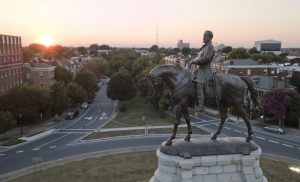AP: Judge not issuing immediate ruling on Robert E. Lee statue removal

RICHMOND, Va. (AP) — A Richmond judge heard arguments Thursday but said he would not immediately issue a ruling in a lawsuit over Virginia Gov. Ralph Northam’s plans to remove an enormous statue of Confederate Gen. Robert E. Lee.
Attorney Gen. Mark Herring’s office asked the court to dismiss the lawsuit and dissolve an existing injunction barring the removal of the statue from historic Monument Avenue.
The lawsuit was filed by William C. Gregory, a descendant of signatories to a 1890 deed that transferred the statue, pedestal and ground they sit on to the state. His complaint argues that the state agreed to “faithfully guard” and “affectionately protect” them.
Richmond Circuit Court Judge W. Reilly Marchant said the matter was of great importance and deserves a written opinion.
The judge decided an injunction will remain for another 30 days but said he expects to issue a ruling well before then.
Gregory’s attorney, Joseph Blackburn Jr., argued that Gregory has legal standing to challenge the governor’s decision to remove the statue and criticized Herring for describing him in a legal brief as a “heckler.”
“He has a very strong attachment to the Lee monument and to describe him as such things is insulting,” Blackburn said.
Blackburn also criticized Northam as “tyrannical,” saying as the governor he doesn’t have the right to establish public policy and tear down the statue.
“He executes the laws; he doesn’t make them,” Blackburn said.
Virginia Solicitor General Toby Heytens said Gregory was arguing that he has the “perpetual right” to “veto” a state’s right to decide what to display on its own property.
“No one can require a sovereign Commonwealth to do something in perpetuity, forever,” he said.
Northam’s administration has been readying plans to remove the enormous statue — should the court clear the way— from a soaring pedestal. He announced plans to take it down in early June, citing the pain felt across the country about the death of George Floyd at the hands of Minneapolis police.
The statue was unveiled before a massive crowd in May 1890, at a time when the Civil War and Reconstruction were over and Jim Crow racial segregation laws were on the rise.
Now cloaked in graffiti, it and other nearby monuments have become a rallying point during social justice protests and occasional clashes with police.
The 21-foot-high (6.4-meter-high) equestrian statue, which the state has said weighs about 12 tons (11 metric tonnes), sits atop a pedestal nearly twice that tall.
Gregory testified Thursday that its removal would cause him emotional distress and would be a “a slap in the face” to his family.
He said he is not a member of any Civil War groups and considers flying the Confederate flag a “racial act,” but considered the Lee statue a tribute to “a great Southern gentleman.”
The state called nationally recognized historian Edward Ayers as an expert witness.
Ayers discussed the history of post-Civil War America, how the effort to establish statues to Confederate leaders emerged and the development of Monument Avenue as a prominent residential district.
He said the Lee statue was more than just a tribute, it was part of an effort to improve the image of the Confederacy at a time when whites were also stifling Black political power.
“By its very size you can see that this is not about remembering a lost man,” Ayers testified.
Richmond Circuit Court Judge Bradley Cavedo, who issued an initial injunction in June and later extended it, dismissed Gregory’s initial complaint but allowed him time to amend it, saying he wanted Gregory’s attorney to have “another shot” at addressing issues of legal standing.
Cavedo recused himself earlier this month, citing the location of his home in the vicinity of the Lee monument. He wrote that he was unaware at the outset of the case that he lived in the Monument Avenue Historic District, a 14-block area that contains the Lee statue.
The judge also heard arguments on a request for a temporary injunction in a separate lawsuit over Northam’s removal plan. That lawsuit was filed by five plaintiffs, four of whom own property in the vicinity of the statue and a fifth who is identified as the trustee of a property owner. Marchant did not immediately rule on the injunction request, but said he plans to issue a written decision soon.
The lawsuit alleges that removal of the statue could result in the loss of the National Historic Landmark designation, “which will have a substantial adverse impact “ on the plaintiffs, ”including the loss of favorable tax treatment and reduction in property values.”
After the hearings, Herring said he’s hopeful the judge will conclude that the governor has the authority to remove the statue.
“This monument is a divisive, antiquated relic and it needs to come down,” Herring said.
Photo Courtesy: FILE – In this July 31, 2017 file photo, the sun sets behind the statue of confederate General Robert E. Lee on Monument Avenue in Richmond, Va. Attorneys will be back in court Thursday, July 23, 2020, for a hearing in a lawsuit challenging Virginia Gov. Ralph Northam’s plan to remove a giant Confederate statue in Virginia’s capital city.(AP Photo/Steve Helber)

